MOTHER EARTH NEWS FAIR
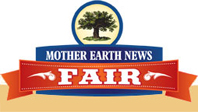 Visit us at Mother Earth News Fair
Visit us at Mother Earth News Fair
Premier's booth #1570 & 1571
Puyallup, WA
May 31-June 1, 2014
Premier's booth #151 & 153
Seven Springs, PA
September 12-14, 2014
Premier's booth —TBA
Topeka, KS
October 25-26, 2014
FOOT CARE
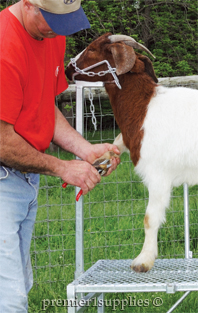
Using Premier ARS 140DXR trimmer and Trimming Stand, which places the goat at an easier height for foot trimming.
Which trimmer is right for you?
| • |
Large hands? You may like The “Premier”™. |
| • |
Small hands? You may prefer the ARS 140DXR & ExoTrim™. |
| • |
Animals with very hard or thick hooves? PowerParer (large flocks) or Hoof Pincher (small flocks or herds). |
| • |
Most comfort? The ARS and ExoTrim are viewed by many as equally comfortable to use. |
How-To Videos
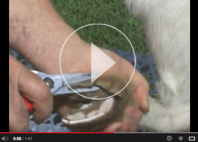
Hoof Trimming
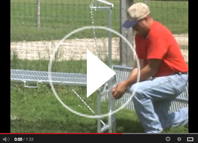
Trimming Stand Assembly
|
DRENCHING
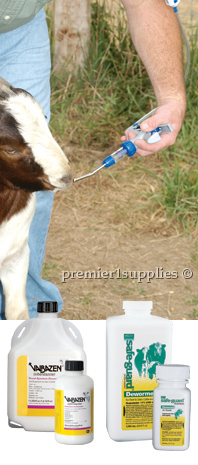
Using the Auto Syringe & Drencher, which refills itself between injections through a plastic tube (included) attached to bottle. 12.5 ml. Premier uses dewormers—Valbazen® and Safe-guard® Drench
For internal parasites
At Premier we deworm by drenching instead of injecting because it is:
| • |
Safer. Less risk if an animal receives too much drench. (Some injectable dewormers, if overdosed, will send animals into shock.) |
| • |
More effective. Experts suggest that it kills a higher % of the parasites. |
| • |
Assures a better pelt and carcass. Vaccinations can damage both. |
| • |
Safer for the operator. No risk of sticking a needle into your hand. |
Not sure what you need? Let us help you…
|
|
 |
 |
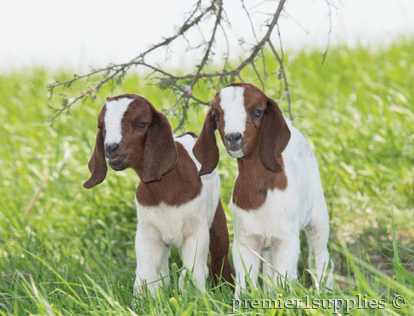
It's kidding season! Our first set of twins for the season are pictured above. They're already right at home in one of the side pastures.
Rambunctious kids abound
For some of the residents at Premier—it seems their kids won't stop bouncing off the walls. They climb anything and everything and find more ways to get in trouble than you can shake a stick. At least they're eating the multiflora rose. Did we mention they're goat kids?
It is (and has been) kidding season for many of the goats in the area, which means herds are expanding and kidding pens are full of energetic kids (the goat type).
Premier's goats are currently enjoying lush green pasture, and they've already had their first set of kids for the season. Once all the does finish kidding, we'll walk them out to our thicket. Out there they can browse briar and bramble to their heart's desire.
In this newsletter we've included articles on pasture grazing/management from Washington State University, weaning information from the University of Maryland as well as an extensive article on kidding from the folks at Cornell University.
GREENER PASTURES
Five Steps to Better Pasture and Grazing Management
Washington State University, Clark County Extension
Grazing season has arrived, are your pastures ready? Good pastures provide forage for your animals, absorb rainfall, filter runoff, and reduce erosion, all of which protect streams. Even good pastures are susceptible to compaction during the rainy months and overgrazing year-round. Bare spots created by overgrazing encourage weed growth increased erosion, runoff, and dust, and may cause poor animal health. Although it may seem daunting, proper pasture management makes it feasible to have lush, green pastures, clean water, and healthy animals.
READ MORE »
The Small Acreage Program is sponsored in partnership by WSU Extension Clark County and the Clark County Clean Water Program.
EXTENSION NEWS
Kidding with Confidence
Cornell University Cooperative Extension
Introduction
Kidding season is a challenging and highly critical time for new meat goatproducers. The success of these first kidding seasons often determines whether new goat farms survive. Not only are productivity and profit limited when herds experience major health problems and death losses at kidding, but the accompanying emotional stress can irrevocably discourage new farmers. Reading books, looking at videos, and listening to experts on kidding can help prepare new farmers, but are nothing like the real thing. Assisting an experienced meat goat producer during his or her kidding season is one of the best ways to learn.
This booklet is designed to help new producers pair up with experienced producers to set up a mentoring situation. The idea is that knowledgeable, experienced farmers are often the best teachers or coaches (i.e. mentors) for new farmers. Farming is an excellent example of a circumstance where learning by emulating programs work effectively. Throughout this booklet, the word “mentor” will be used for the producer doing the guiding or coaching and the word “mentee” rather than trainee or student will be used for the new farmer.
READ MORE »
Text and Illustrations: Dr. Tatiana Stanton, Extension Associate
Assisted by past mentees, Susan Jaffe and Nancy Weber
Technical review: Drs. Mary Smith and Pamela Karner, DVMs
WEANING GOAT KIDS
Weaning primer
by Susan Schoenian, University of Maryland Extension
Weaning is when the milk is removed from the diet of a young mammal. Usually – but not always – it coincides with separation of the young from their dam.
Weaning age varies greatly in sheep and goats, from as early as 14 days to natural weaning, at more than four months of age. Lambs have been successfully weaned as early as 14 days; kids as early as 28 days. Early weaning is usually defined as weaning prior to 90 days of age; 60 days is most common. Late weaning is anything after that.
Wean by weight
It is generally better to wean based on weight rather than age. A general recommendation is that lambs and kids not be weaned until they have achieved 2.5 to 3 times their birth weight. Artificially-reared lambs and kids should weigh at least 20 to 25 lbs. before being weaned. If lambs are being raised by their dams, they should weigh a minimum of 40 to 50 lbs. before being weaned.
Even more important than weight is dry feed consumption, as weaned lambs and kids need to be consuming enough dry feed to support their maintenance and continued growth – in the absence of milk in their diet. Their feed consumption should be at least 1 percent of their body weight at the time of weaning. Creep feeding is an aspect of most early weaning programs.
There are many factors to consider when deciding at what age to wean lambs and/or kids. These include age, season of birth, potential parasite problems, predator risks, markets, labor, facilities, and forage resources. There are pros and cons to different weaning ages.
READ MORE »
See all of Premier's Kidding Supplies.
|
|